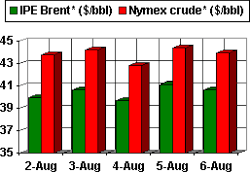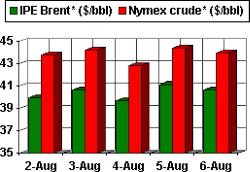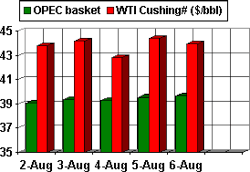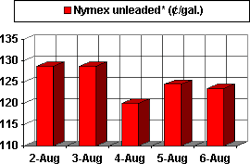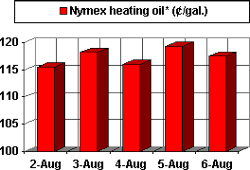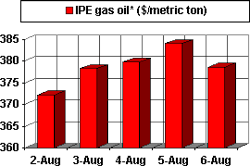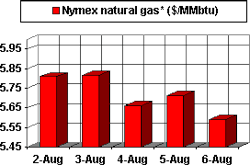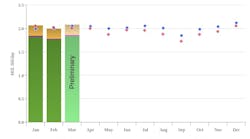US natural gas prices are showing signs of weakness, but the long-term outlook continues to be one of strength.
The near-term price weakness stems from expectations of ample supply this coming winter. Injections into storage continue at a robust rate. This was helped along by a recent spell of unseasonably cool temperatures. Temperatures lower than normal in the US Midwest and Northeast at the end of July spurred a sizable increase in injection rates. For the week ended July 30, net injections totaled 83 bcfvs. a 5 year average injection rate of 53 bcf for the period, notes Ohio energy economist James Williams, president of WTRG Economics.
"To reach the highest storage level on record, the US needs to add 874 bcf by the end of October," Williams said in a July 31 research note. "That requires injections of only 67 bcf per week, which is easily within the capability of the industry, given current levels of drilling activity."
Oil price role
The other critical factor in setting gas prices now is a crude oil market that seems comfortably settled in at more than $40/bbl (for New York next-month futures contracts).
Williams notes that when US gas storage levels are near or above their 5 year average, crude oil typically sells at a premium to gas on a btu basis. For the week ended July 30, that premium was $1.45/MMbtu.
"If storage continues to build at a normal rate, prices should drop to $2 below crude [on a btu-equivalent basis]," Williams said. "In the last 6 weeks, gas prices have gone from $0.10 to $1.71 below crude.
"It is entirely possible that the margin could increase to $2.50. At current crude prices, that would put a $5 floor on spot gas."
However, the storage pace could slow as gas begins to look more economically attractive to power plants and they consequently switch from fuel oil, pushing up gas demand.
Gas production slide
With gas prices having jumped 40% in the past 24 months, gas drilling this summer is at its highest level since July 2001.
The last time that happened, the accompanying production spurt helped squeeze gas prices back down to around $2/MMbtu.
Odds are slim that there would be a repeat of that price slump, according to Marshall Adkins, analyst with St. Petersburg, Fla.-based Raymond James & Associates Inc. That's because, in his view, US gas production "is heading firmly downwards, despite a massive increase in drilling activity."
RJA's survey of publicly traded producers accounting for over 60% of US gas production suggests that those producers posted a 3.8% year-to-year decline in gas output in the second quarter. That compares with average quarterly year-to-year declines in 2003 of 2.25%.
The key here is to remember that, despite a 44% increase in the gas-directed drilling rig count during the past 2 years, US gas output continues to fall.
"That means price rationing remains the only viable option to bring the gas market into equilibrium," Adkins said in an Aug. 9 research note.
While it must be recalled that a production spurt tracked the 2001 drilling surge, RJA is forecasting a decline in production this time around.
Adkins takes issue with the production estimates provided by the US Energy Information Administration; the agency data show a year-over-year production increase of 0.6% for 2003: "This conclusion from the EIA seems to defy common sense when one considers that our surveys cover 47 of the largest natural gas producers in the US, representing roughly 60% of total domestic gas production.
"Given that 60% of production was down 3.8% year-over-year in 2Q04, the other 40% would have to be up a whopping 5.7%, in order for total production just to break even. Expecting such a massive level of growth from the small, mostly privately held, producers outside our survey is wishful thinking, at best."
The RJA analyst pointed out that majors and integrated energy companies show the biggest year-to-year decline in gas output in the second quarter at nearly 10%. He also warns of further production declines from this group, where drilling activity has been roughly flat since early 2003.
"The independents are driving nearly all of the drilling activity increases, with little production response to show for it."
With a few more quarters of such declines and with oil prices near $40/bbl, that suggests gas priced above $7/Mcf, Adkins says.
If a producer is running full out just to keep output from totally collapsing, that's not such a bad place to be.
(Author's e-mail: [email protected])
OGJ HOTLINE MARKET PULSE
Latest Prices as of Aug. 9, 2004
null
null
null
null
null
null
NOTE: Because of holidays, lack of data availability, or rescheduling of chart publication, prices shown may not always reflect the immediate preceding 5 days.
*Futures price, next month delivery. #Spot price.
